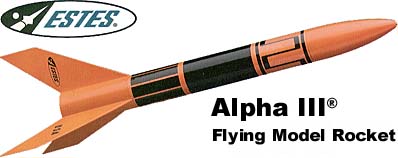Alpha III
I was planning to build an upscaled Estes Alpha II as my level-3 certification rocket, but there are some problems with this rocket. The swept-back fins make recovery difficult and the relatively stubby shape makes it a tight fit for dual-deployment. Also, the huge fins cause some interesting stability issues. As a result, I decided to build a generic rocket for my level-3 certification and just build the Alpha as the first rocket to fly after I'm certified.
 An upscale of an Estes Alpha has been done before
(I saw one fly at LDRS 17 this year,
although unfortunately I didn't get the builders name),
but I still think this is a good idea.
The Alpha is the longest-running and most basic kit
Estes makes. In its current incarnation, the Alpha III, the rocket is very
easy to build with its molded plastic fin can.
Of course, a rocket capable of surviving a level 3 fight will entail much more work.
This is that story.
An upscale of an Estes Alpha has been done before
(I saw one fly at LDRS 17 this year,
although unfortunately I didn't get the builders name),
but I still think this is a good idea.
The Alpha is the longest-running and most basic kit
Estes makes. In its current incarnation, the Alpha III, the rocket is very
easy to build with its molded plastic fin can.
Of course, a rocket capable of surviving a level 3 fight will entail much more work.
This is that story.
This rocket has been abandoned. (I got level 3 certification with my Generic Rocket.)
The Pictures
Design Background
The first thing to do is figure out what size our upscaled Alpha will be. Below are the parts which come with the Estes Alpha III kit and a table of the relevant measurements. This provides a start for the scale-up of the rocket.

| Part | Dimension | Measurement | Calibers |
|---|---|---|---|
| body tube | length | 197mm | 6.3 |
| diameter | 25mm | - | |
| fin | root length | 57mm | 2.2 |
| tip length | 31mm | 1.2 | |
| span | 39mm | 1.5 | |
| sweep | 70mm | 2.8 | |
| nose cone | length | 66mm | 2.6 |
| overall body length | 263mm | 10.5 | |
Basically, all the dimensions are pretty standard for rockets, except that the fins are a little oversize. This isn't noticeable in a model rocket but becomes more of a problem in a high-power rocket. The dimensions above result in a CP of 220mm from the nose tip, which is somewhat into the fins (see CP Calc results). This model certainly doesn't need any nose weight!
I wanted this rocket to be large enough to handle M motors, but not so large that I couldn't launch it off a ProRail (see my Big Kahuna launch story for what not to do). So, my target was under eight feet tall and under thirty pounds dry. Since the Estes Alpha III is ten and a half times as long as its diameter, an 8' rocket would be about 9" in diameter. The table below shows scaled-up dimensions for a 9", a 7" and a 2.3" airframe.
| body diameter | 9" | 7" | 2.3" |
|---|---|---|---|
| overall length | 96" | 73.5" | 24" |
| body tube length | 72" | 55" | 18" |
| nose cone length | 24" | 18.5" | 6" |
| fin root | 20" | 15.75" | 5.25" |
| fin tip | 11" | 8.75 | 2.75" |
| fin span | 14" | 10.75" | 3.5" |
| fin sweep | 25" | 19.5" | 6.25" |
| conversion factor | .365 | .280 | .092 |
| plans |
An airframe of 9 1/8" would result in an 8' rocket, but this isn't a standard body tube diameter. It is possible to order airframe tubing in arbitrary sizes, but there is a minimum order of $100 per "part" and of course I would need couplers too. However, Missile Works had 7" flexible phenolic, which is the basis for the 7" airframe above. Pius Morozumi also suggested I build a prototype because the fins are a bit large and he thinks they will have a tendency to break on landing. The 2.3" airframe is based on 54mm flexible phenolic body tubing and will be the prototype airframe tubing.
The nose cone will have to be custom made, I plan to have someone turn a custom nose cone, which I will use as a plug to build a fiberglass mold. This will make the airframe entirely fiberglass. For the 7" diameter rocket, the fins will be .125" G-10 core with 1/4" plywood laminated to both sides. The fin taper (3/4" at the root to 3/8" at the tip) will be formed in the plywood, with the G-10 core providing the strength.